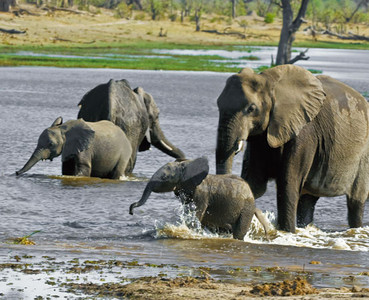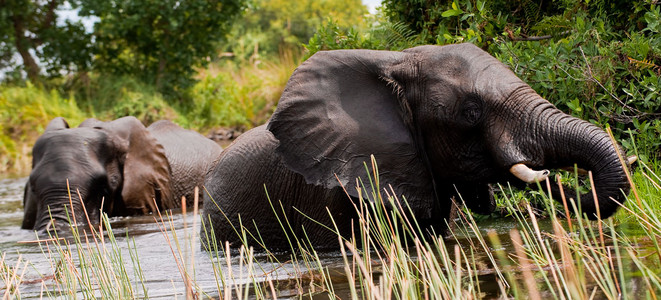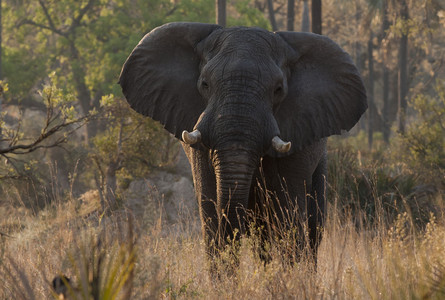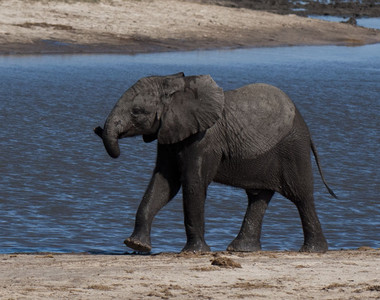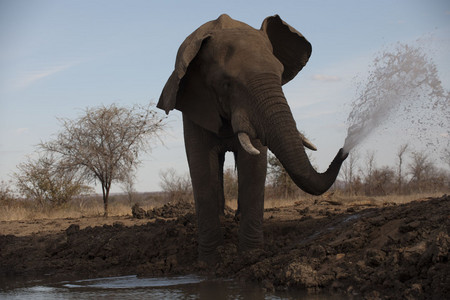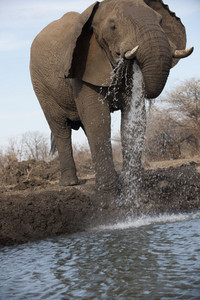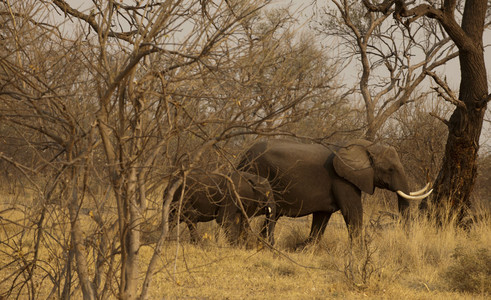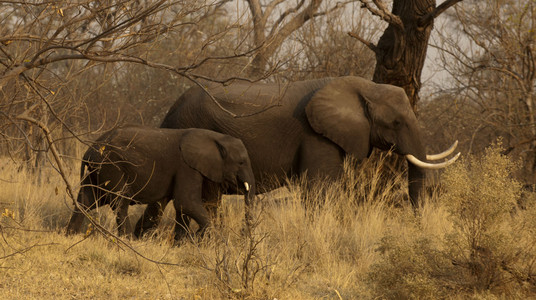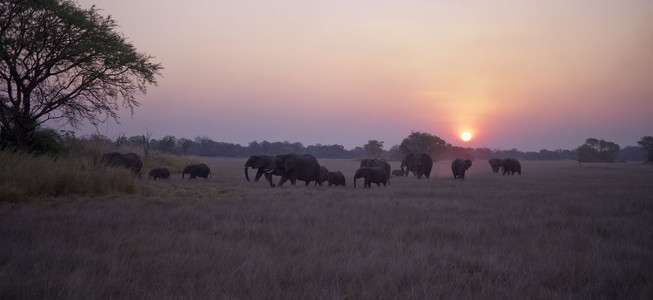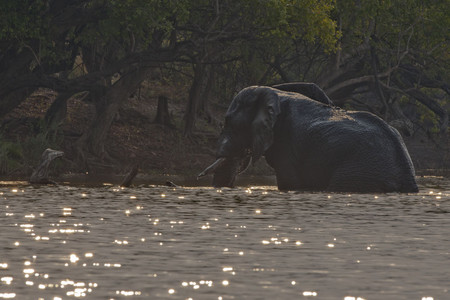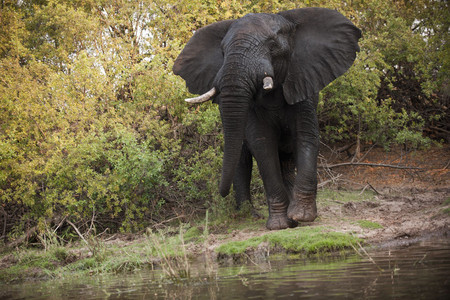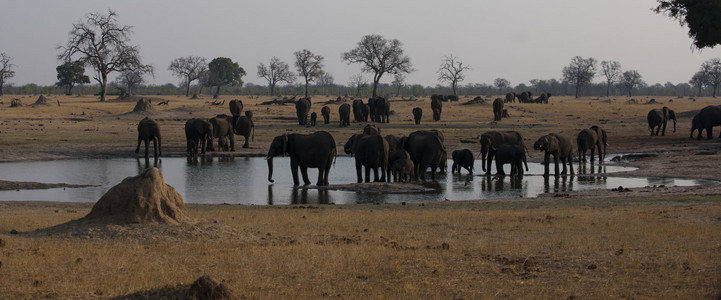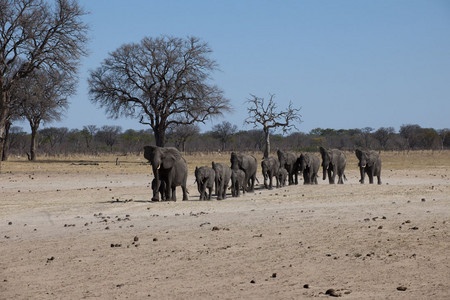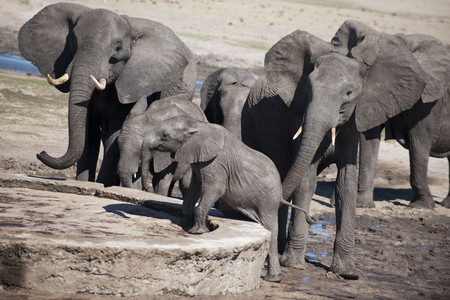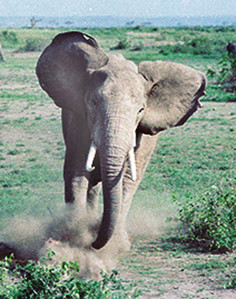
Elephant Mock Charge
The 10,000 pound bull was in an irritable mood and decided to charge us. I wish that I knew then what I learned later, because I was scared stiff that the big fellow was going to ram our vehicle. However, he stopped about 25 feet away. One can diferentiate a mock-charge from a serious one: if it had been a serious charge, his ears would have been plastered against his head, and his trunk would have been rolled up tightly under his mouth. However, there's no way of knowing if an elephant is going to change his mind after he's started a mock charge. We could not have outrun him, because we had stopped, and he was too close and already up to speed. [Serengeti, Tanzania].
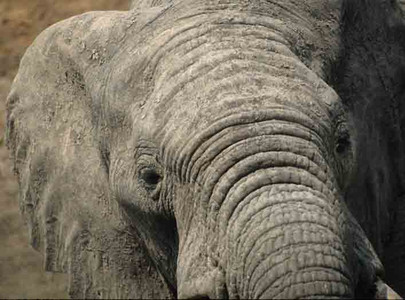
Elephant Female
A portrait of an unusually large female elephant, which I was able to photograph from close-up. [Big Tom's, Hwange NP, Zimbabwe].
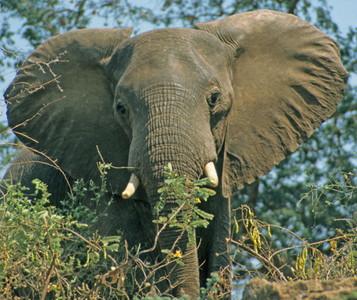
Bull Elephant
Close-up view of a huge bull Elephant who looks like he has worn down, or broken, his tusks. [Matusadonna, Zimbabwe].
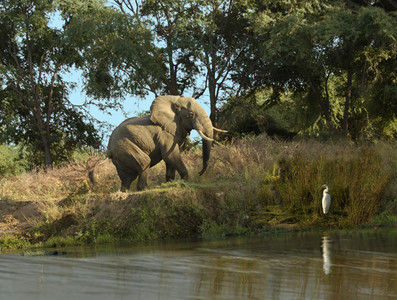
Tranquil Elephant
I think that this is a beautiful picture of tranquility: A bull Elephant, bearing a pair of beautiful tusks, walking along the Zambezi River. The great white egret (lower R), busy fishing, helps make the composition. [Zambezi River, Zambia].
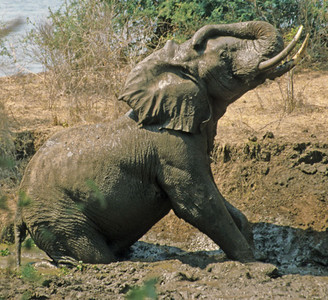
Elephant Bathing
A bull Elephant with beautiful tusks luxuriating in a mud-bath to rid himself of the pesky insects that like to inhabit the creases in his skin..[South Luangwa NP, Zambia].
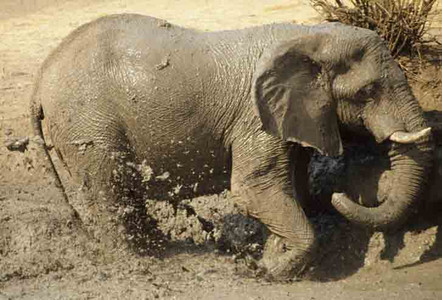
Elephant Mudding
Elephant bull "mudding": The bull is throwing the mud beneaath his body, but he will soon start tossing it over his back as well. An elephant does this to combat the irritation from insects that get into cracks in his thick skin. [Hwange NP, Zimbabwe].
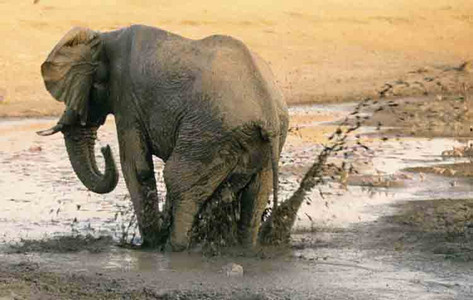
Elephant Mudding
Another view of a different Elephant bull "mudding". he's throwing mud onto his underbody. [Hwange NP, Zimbabwe].
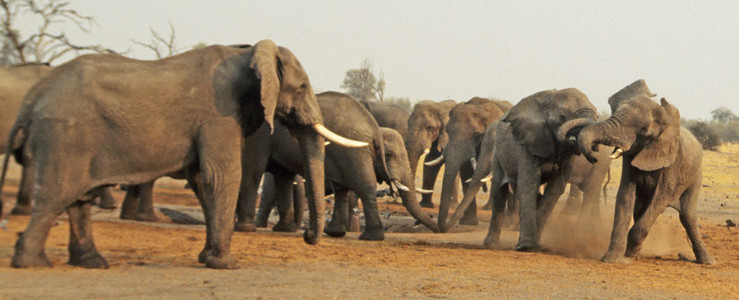
Water Hole Crowd
About 50 bull Elephants are waiting to get a drink, but the water-hole was almost dry. They had been waiting patiently for some time for those at the water to finish and leave, but after a while, tempers flared, resulting in some pushing & shoving between very thirsty bulls.The loud clashing of the tusks & the forces produced by these behemoths struggling against one another, was impressive. When we returned the next morning, the ground was strewn with pieces of ivory--broken tusks. [Savuti, Chobe NP,Botswana]. [

Water Hole Crowd
Elephant Bulls waiting to drink: These are just some of the bulls waiting so patiently for a drink. The water supply here looked pretty skimpy to me, knowing that each thirsty bull could consume almost 100 gallons. Later that evening, the man in charge of these waterholes explained that he had deliberately ordered all the water shut off to encourage the elephants to trek another 10 miles or so to reach the plentiful water of the delta. I don't know if this worked, but I thought it was a little cruel. [Savuti, Botswana].
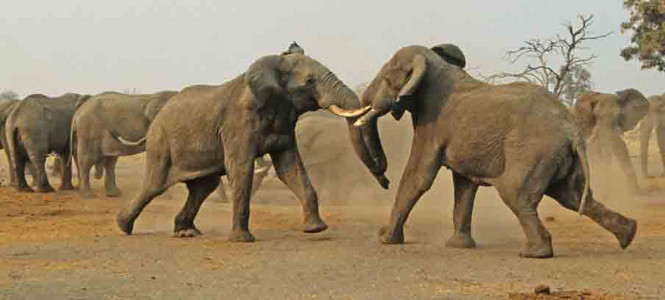
Water Hole Confrontation
The tempers have flared between the same two very thirsty bulls.They began shoving one another. We could hear their tusks knocking together. Some of the others lost their patience as well, causing a lot of grunting and tusk-clacking. It was inevitable that the mighty forces being exerted by these huge beasts would result in breaking some tusks. [Savuti, Botswana].
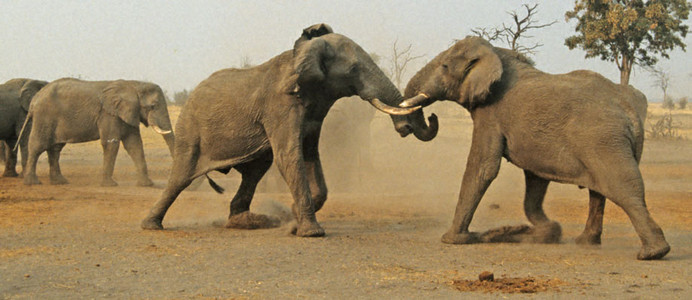
Water Hole Confrontation
Elephant: The pushing and shoving of the previous pair continued. This was not serious fighting--just a way for them to 'let off steam'! The only damage that will occur is perhaps breaking the tusk. Note that the animal on the R already has a broken tusk that is white and sharp, suggesting that it might have happened very recently. As an elephant grows older, the tusk (an incisor tooth) becomes more brittle because the tusk's marrow diminishes. [Savuti, Chobe NP, Botswana].
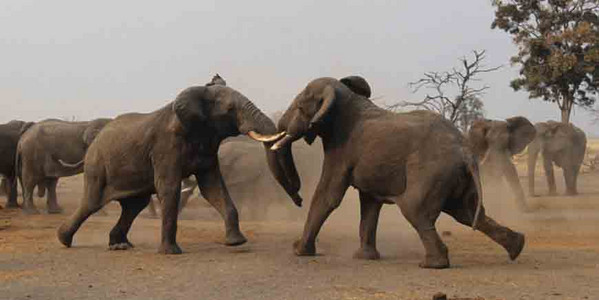
Water Hole Confrontation
These two Elephant bulls look about evenly matched in size. The one on the R, with a broken tusk, looks like he has a heavier body. The one on the L has nice intact tusks. Elephant tusks are an incisor tooth. Elephants can grow only 6 sets of teeth. When these wear out, the animal becomes edentulous and they are unable to chew their food, and they starve to death. Therefore, their life expectancy is influenced by their food. If their food has had a lot of sand it it, or if they are forced to eat a lot of bark, the teeth will wear down quicker, compared to teeth of those elephants who can feed on soft, succulent water grass. [Savuti, Chobe NP, Botswana].
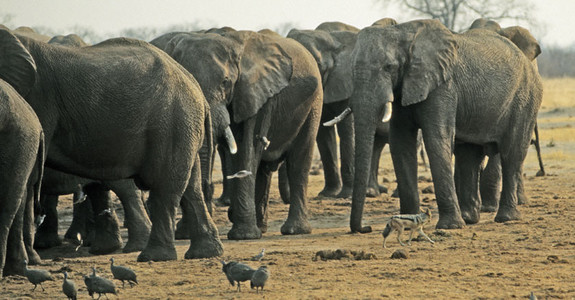
Jackel Prowling among Elephants
A jackel prowls freely and uninhibitedly amongst the thirsty elephants (R, at foot of elephants). The jackal is so small that the eles pay no attention to him, but it will be different when some different species come to drink, as seen in the next 2 images. There are also some guinea fowl in the foreground, all of whom are thirsty and looking for a drink. [Chobe NP, Savuti, Botswana].
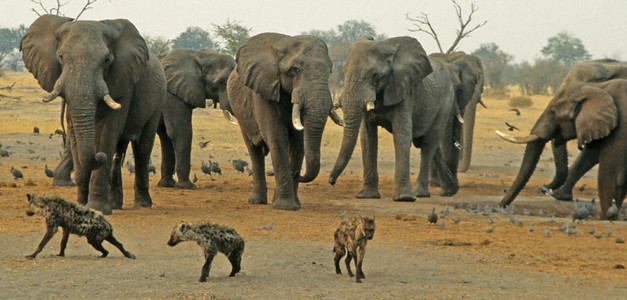
Elephants Confronting Jackals and Hyenas
Here we see a second species, Spotted Hyenas, arriving and hoping to get a drink. They don't stay very long--not that it would have done them any good, because the Elephants are very thirsty and not inclined to let anything drink before them. Note that the bulls are paying close attention to the hyenas, which they hate, because they are serious predators of the elephant young. (See subsequent images of an adult elephant with amputated trunk). [Chobe NP, Savuti, Botswana].
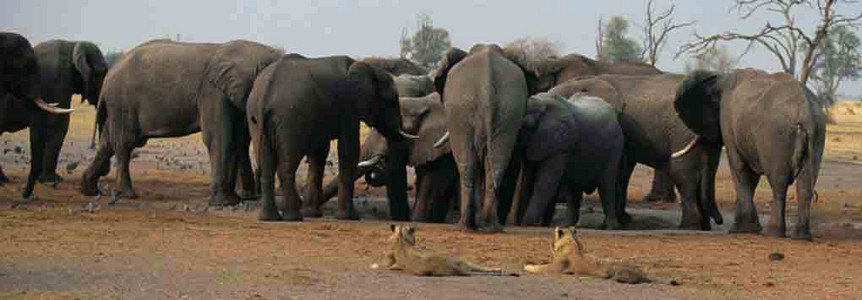
Elephants with Lionesses
The lionesses' arrival has scared off the jackel, hyenas, and birds, but the bull Elephants, in the absence of baby elephants, feel no threat--although they do have a natural dislike of the big cats! See the next 3 images to see the elephants' reaction to the lionesses presence. [Chobe NP, Savuti, Botswana].
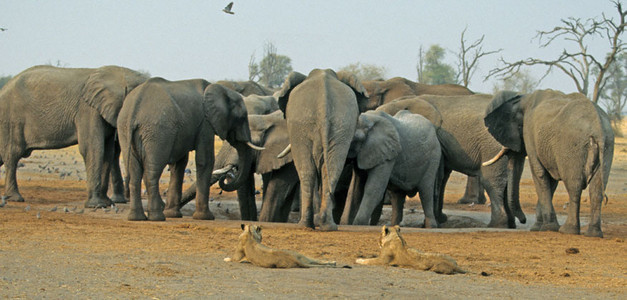
Elephants with Lionesses
The lionesses are waiting patiently, and the bull Elephants have not yet reacted to their presnce. With all the bulls in the area, their chance of getting water is nil. {Chobe NP, Savuti, Botswana].
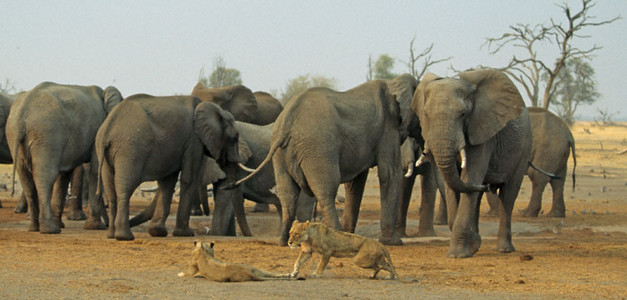
Elephant Confronts Lionesses
Elephant and Lionesses-3rd Image: A bull, already irritable from thirst, decides he doesn't want the big cats around, and so he chases them off. The other elephants paid the lionesses no heed. I was impressed with how slowly the lionesses struggled to their feet to comply with a bull elephant. [Chobe NP, Savuti, Botswana].
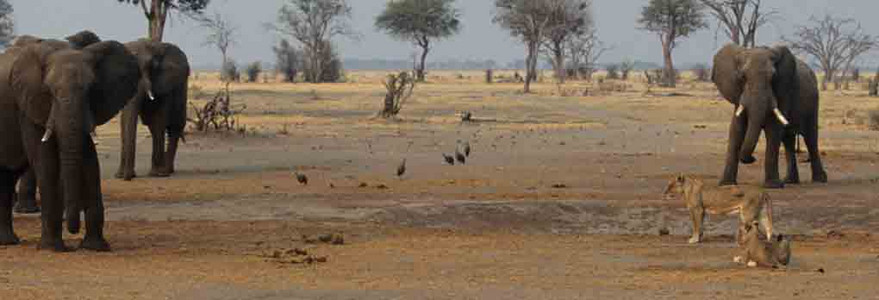
Elephant Chases Lionesses-6th Image
The two lionesses reluctantly get up slowly and leave. [Savuti, Botswana].
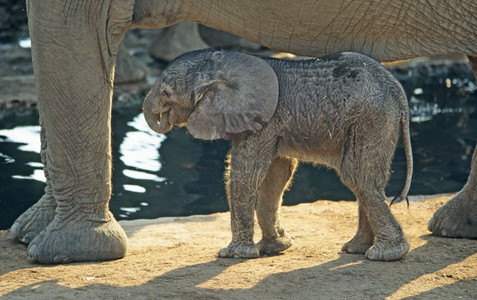
Baby Elephant
This is the youngest baby elephant that I have seen in 15 african safaris. We estimated that the baby was around a week old. It stood beneath its mother, providing a good size comparison. I was fortunate to have back-lighting to show the hairs on the legs and abdomen. The wrinkling of the skin from the amniotic fluid in utero, can still be seen. The infant probably weighed about 220 lbs. at birth. [Masuma Dam, Hwange NP, Zimbabwe].
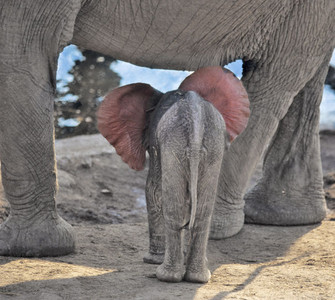
Baby Elephant
The posterior surface of baby Elephants' ears is red because of a rich plexus of veins beneath the thin baby skin. This provides the means by which all elephants ventilate their body heat. Ear-flapping augments the heat dissipation. As mentioned previously, the wrinkled skin is caused by long immersion in the amniotic fluid. The gestation period for African Elephants is 22 months. [Masuma Dam, Hwange NP, Zimbabwe].
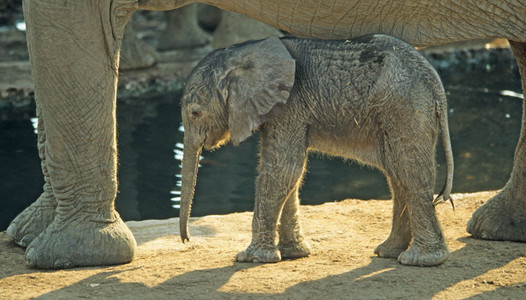
Baby Elephant
The same very young Infant Elephant as previous. The body hairs, especially on the legs and abdomen of the infant, are well seen in this back-lighted photo. Elephants conceive--& usually produce only one baby--about every 3-5 years. [Masuma Dam, Hwange NP, Zimbabwe].
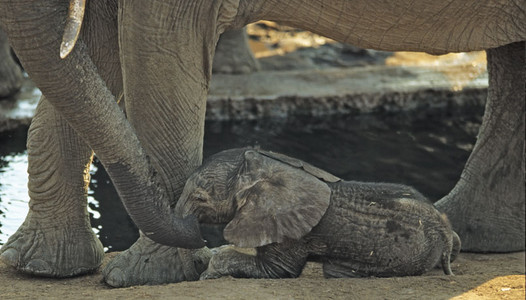
Baby Elephant
The baby has gotten tired from standing so long, and had laid down at his mother's feet. Mother reaches her trunk down to check on her infant. [Masuma Dam, Hwange NP, Zimbabwe].
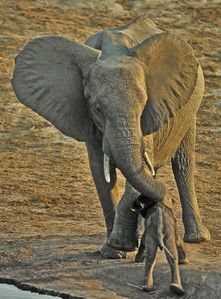
Baby Elephant
While the mother and baby were leaving the waterhole, the baby slipped and fell into one of the pools of water. Mother had to pull him out. [Masuma Dam, Hwange NP, Zimbabwe]
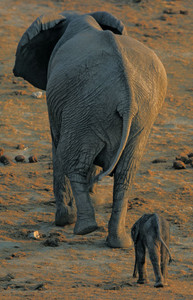
Baby Elephant
Mother and her baby walk off together. One can't help be awed when contemplating how large this small male will become. [Masuma Dam, Hwange NP, Zimbabwe].
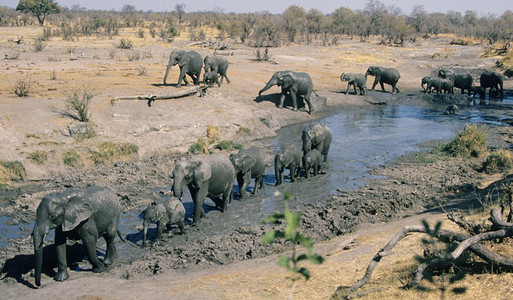
Baby Elephant Walk
A matriarchical elephant herd walks up-stream to bathe, wallow in the mud, and drink. All family herds are led by a large, elderly female. The other females are usually all related to the matriarch, i.e., sister and younger females who help raise and protect the smaller members and babies. There may be young males who contribute to the care in the herd, but they are usually driven out when they reach approximately 8 years oif age. [Big Tom's, Hwange NP, Zimbabwe].
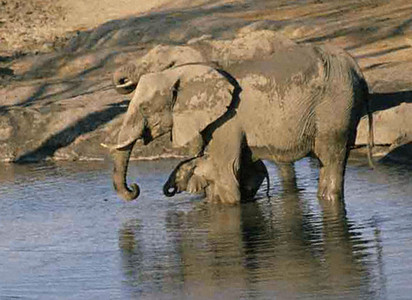
Elephant Calf
Elephant with baby between female's Legs: The mother & its aunts take the youngster (2 mos.) into the water to teach it how to drink with his trunk, to play, mud-bathe, and get used to being in the water. [BIg Tom's, Hwange NP, Zimbabwe].
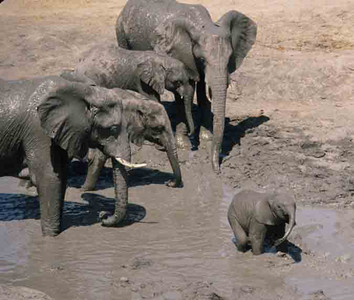
Baby Elephant in Mud
A baby (of about 2 months) plays in the muddy water is carefully watched by other members of the family. A baby elephant doesn't have good control of its trunk until it's 2-3 mos. [Big Tom's, Hwange NP, Zimbabwe].
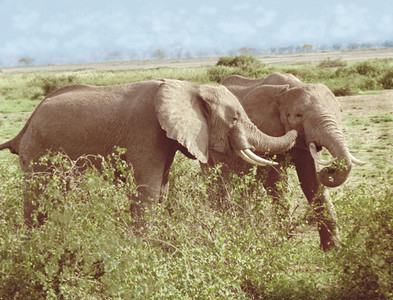
Elephants
This gesture of one bull Elephant inserting his trunk into another bull's mouth, is thought to be a gesture of friendship or comradship. [Serengeti, Tanzania].
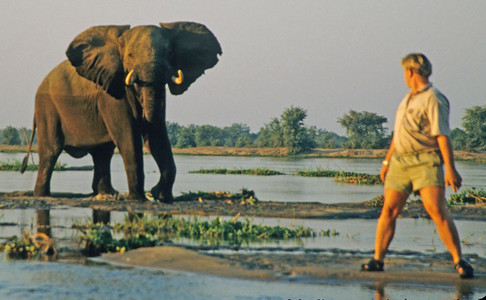
Elephant and Guide
We were sitting in a small boat photographing this bull eating the grass that he had pulled up from the bottom, when the young man (our guide) asked me what I thought of the spectacle. I told him that it had gotten boring--no action! "Boring, is it? I'll change that!", he blurted as he jumped into the shallow water and walked towards the elephant. (see next image). [South Luangwa River, Zambia].
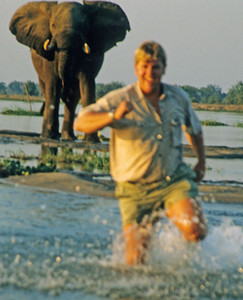
Elephant Scares Guide
As he got near the Elephant, the bull wheeled around and let out a huge roar. You can see the man's response---he was back in the boat before you could count to five. (see previous image). [South Luangwa River, Zambia].
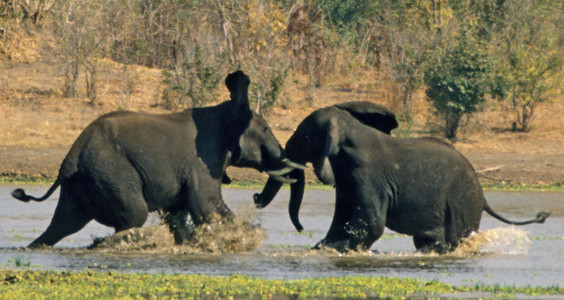
Elephant Play Fight
Elephants playing in water-1st Image: Elephants love to wrestle with each other in the water. Two young adult bulls are tusk wrestling. [South Luangwa NP, Zambia].

Elephant Bulls in Water
Small herd of bull Elephants frolic in the river. [South Luangwa NP, Zambia].
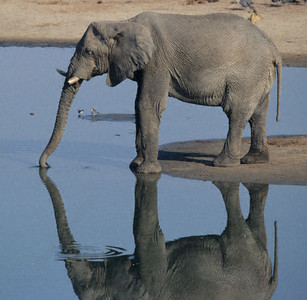
Elephant
A young male Elephant dawdling with his trunk in the water--and making a lovely reflection. [Masuma, Hwange NP, Zimbabwe].
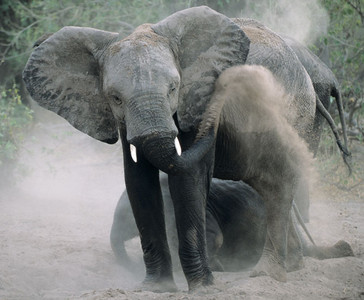
Elephants Dusting
A matriarch, and another female behind her, dusting themselves after bathing.The youngster beneath her abdomen seems not to be enjoying the event. Elephants can suck up a large amount of dust in their trunk, enabling them to blow out a dense cloud. Note the billow coming out of the front one's trunk. They do this to help relieve themselves of insects that like to crawl into the cracks in their skin. [Chobe NP, Botswana].
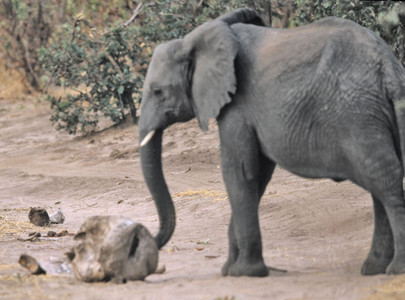
Elephants with Skull
It is thought that when an Elephant dawdles with an elephant skull (or portion thereof), it does so knowing that the object once belonged to an elephant. Elephants are thought to be fascinated by their specie's remains. [Chobe NP, Botswana].
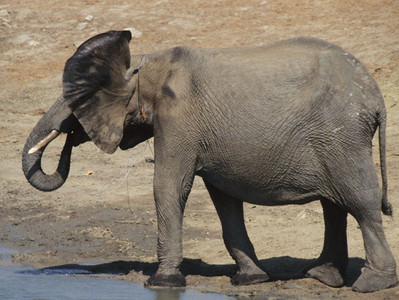
Elephant in Wire Snare
This unfortunate bull had stuck his head into a native's wire snare. He probably did this when he was smaller, because it appears to be snug around his neck and causing a visible ulceration. It's no wonder this fellow was irritable and chased all the impala away from where they were drinking. Natives set snares to catch small game, but it is illegal. Park personnel organize search parties to find and destroy them. [Masuma Dam, Hwange NP, Zimbabwe].

Burning Elephant Dung
It is said that Elephants hate the odor of smoke coming from burning elephant dung. This fire was started by one of the native park personnel carelessly dropping a lighted cigarette butt into some elephant dung. Behind the elephants is a watering hole that was drying up, but inspite of the rancid air, these desperately thirsty bulls still hung around.to get some water. [Savuti, Chobe NP, Botswana].
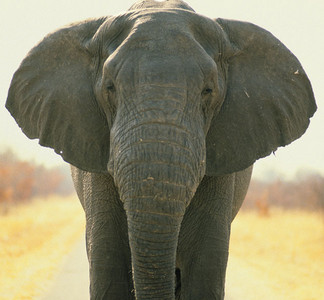
Young Elephant Bull
This is a young bull, about 15 years old, who was born without the ability to grow tusks. One can tell this a congenital malady (and not broken off), because there is no 'socket' where a tusk had developed in his jaw. It would have been interesting to learn what other teeth he has. The tusk is a incisor tooth. It is not uncommon to see bulls with only one tusk and a flat area on the other side from which the other tusk should have grown. [Moremi NP, Botswana].
Bull Stares at Us
A curious 55-yr-old bull who came up to the front of our open vehicle, and stood motionless with his trunk against the bumper, staring at the driver and me for about 10 minutes. Neither of us moved. I just stared back. One can't help wondering what he was thinking. His broken tusks and wrinkled skin indicate that he had a lot of 'milage' on him. He then suddenly pulled away from our vehicle and rejoined some other elephants nearby. [Moremi NP, Botswana].
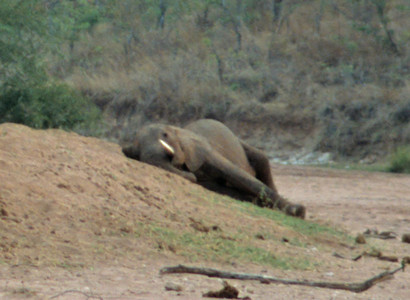
Resting Bull Elephant
When I first saw this, I thought the Elephant bull was dead. When we began to drive towards him, he began to stand up. The bull was just making 'getting up' easier for himself. Pretty good cognitive function, wouldn't you say? Please see the next 3 images. [Matusadona, Zimbabwe].
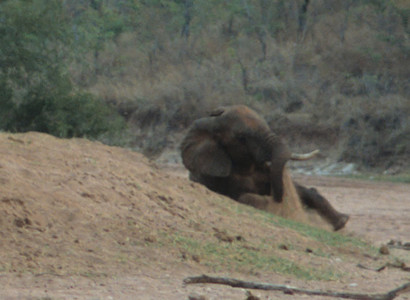
Resting Bull Elephant
Elephant getting up-2nd Image: Please see caption of 1st Image. [Matusadona, Zimbabwe].
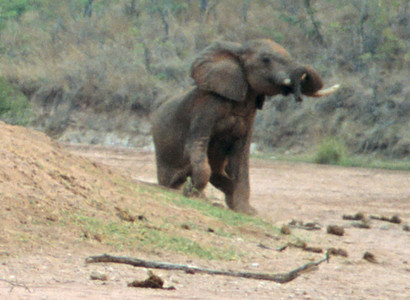
Resting Bull Elephant
Elephant almost standing up-3rd Image: Note that he has hung his trunk on his tusk. He must have been tired. This is a favorite gesture by elephants to ease the burden of the 200 lb. trunk. (Please see caption of the 1st of this series). [Matusadona, Zimbabwe].
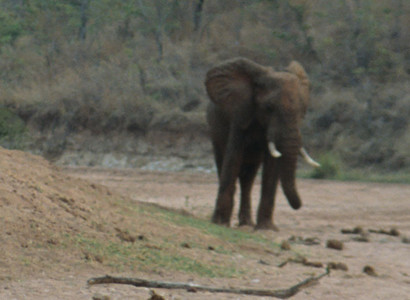
Resting Bull Elephant
Elephant is up walking (4th Image), and perhaps going where he won't be disturbed by curious people like us. (Please see the previous 3 images of this series). [Matusadona, Zimbabwe].
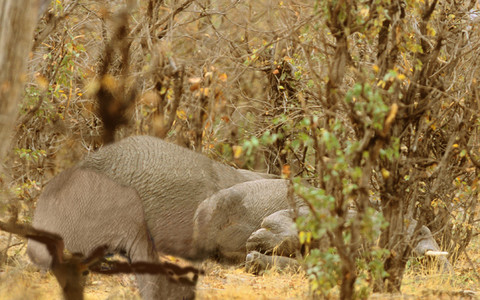
Sleeping Elephant
I have frequently heard people say that Elephants always sleep standing up, and so I included this and the previous series of images to demonstrate otherwise. It is probable that elephants, when tired, will lie down if they feel secure in doing so. [Moremi NP, Botswana].
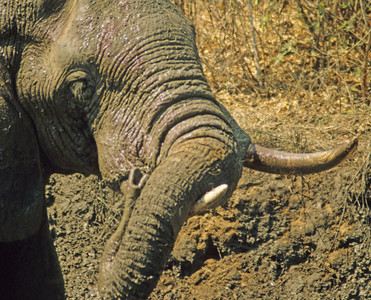
Muddied Elephant
A freshly "mudded" Elephant bull rests his trunk on one of his tusks. A common gesture that elephants use to shift the burden of the 200 lb. weight dangling from the end of their head. {South Luangwa, NP].
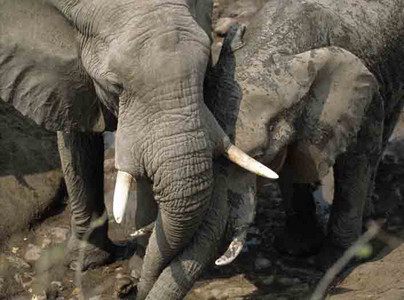
Pushy Elephants
The large female in the center has been hogging all the water for too long. Her companion (R side) agrees, and has cradled its head, trunk and tusks against her trunk to gently push it away from the water. [Big Tom's, Hwange NP, Zimbabwe].
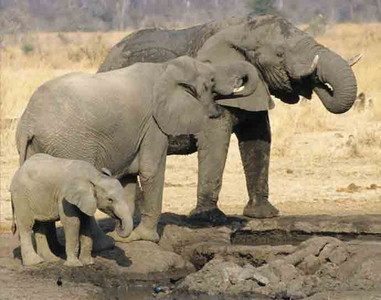
Elephants Drinking
A matriarch (behind), with two younger members of the herd in front, standing at the water, drinking.The smallest is probably a year old. I liked the three in a row, with their trunks curled to their mouths. [Hwange NP, Zimbabwe].
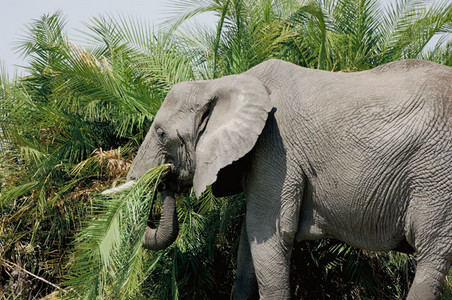
Elephant Eating
I had never before seen an Elephant consume a side of a palm tree, but this one seemed to enjoy the foliage. [Botswana].
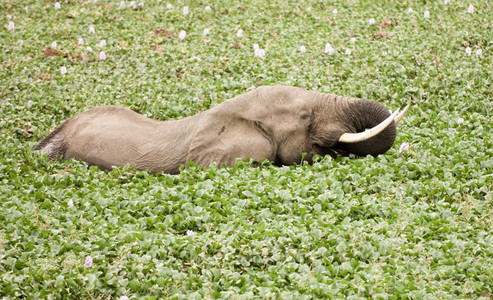
Elephant Eating Hyacinth
I had never before seen an Elephant eat water hyacinth, but this young bull was gobbling it up with gusto. [South Luangwa NP, zambia].
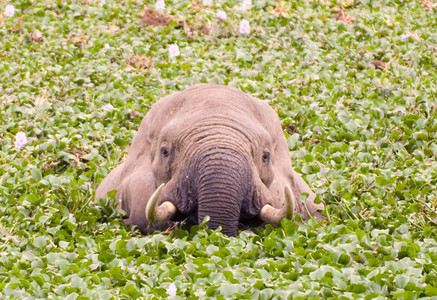
Elephant Eating Hyacinth
Same Elephant as in the previous image. I was amused by the bald appearance of this young bull caused by his ears, and most of his trunk, being buried under the water hyacinth. [South Luangwa NP, Zambia].
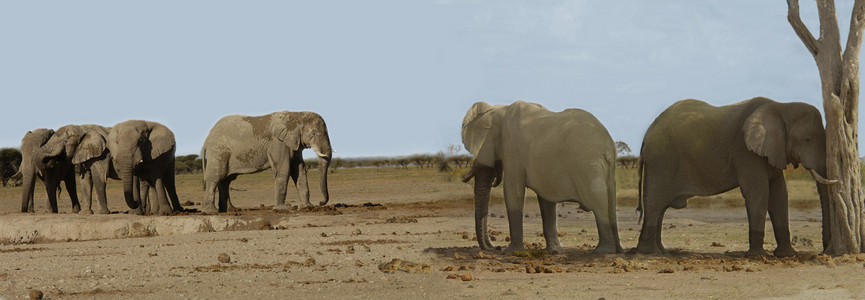
Elephant Scratching Head
An Elephant is scratching his forhead against the trunk of a dead tree. Often one sees tree-trunks that are very polished on one side. This is producd by elephant's repeated scratching some part of their body against the trunk. [Savuti, Botswana].
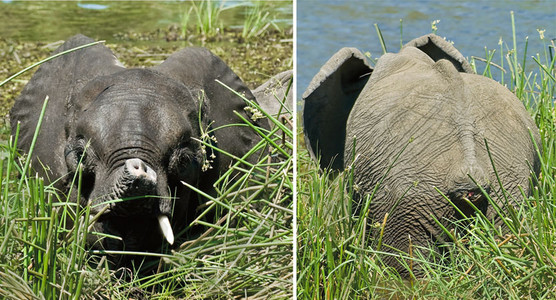
Elephant with Amputated Trunk
It was a rare sighting of a 5-6 year-old adult male Elephant, with an amputated trunk & tail. There was only about 6-8 inches of trunk, and no tail. Undoubtedly, it had been bitten off when he was very little--most probably by hyenas, or possibly a lion. (His mother must have been overwhelmed and unable to protect him). He had just left a group of bull elephants, because he was unable to forage enough food. He needed a lot more time.Thus, he was forced to go off on his own. Watching him feed was pathetic. He could not gather--and bring to his mouth--a normally large bunch of foliage, but had to grasp with his jaws and swallow only a stem or two at a time. A very tedious and unsatisfactory process for this large animal!, when you consider that an adult will consume 300 lbs./day. We saw him working in this marsh from dawn to dusk. Another very important consideration is his loss of a very crucial weapon--the trunk! Alone, he will not be able to defend himself from an attack by a pack of carnivores. (A slap from a 200 lb. trunk could kill an attacker). His handicap will prevent his surviving very long. He will die of starvation, or be brought down by predators. [Khwai, Botswana].
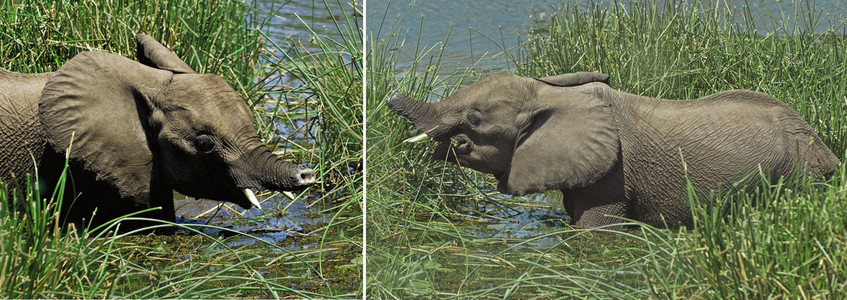
Elephant with Amputated Trunk
A trunkless (and tailess) elephant feeding: These photos show his slow, insufficient nad inefficient eating process. He would require 500 lbs. of food per day, because elephants very inefficiently digest--maybe only 50-60% of what they eat. His trunkless and isolated state do not bode well for a secure future. How will he be able to maintain his nutrition, adequate water intake, and defend himself? It is very likely that he will become weak, and then be pulled down by a pride of lions or a pack of hyenas, (Please refer to the previous image and caption). [Khwai, Botswana].
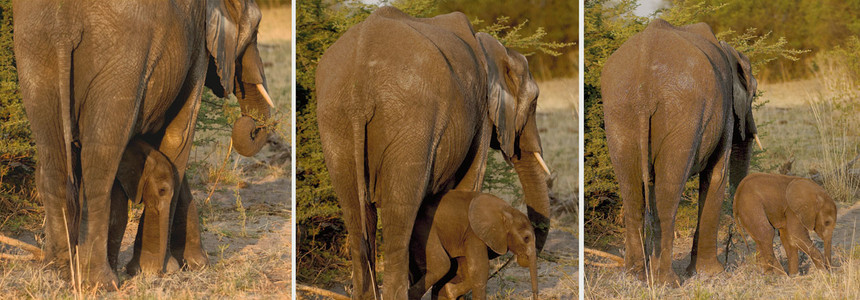
3 Month Toto
A 3-month toto emerging from beneath its mother. [Kwando, Botswana]. Elephant-mother with very young toto (2 mos)-Triple Image: Toto emerges from beneath its mother's belly. [Botswana]. 9Triple Image: A young toto

Matriarchal Herd+Toto-dbl
Matriarchal herd and two totos (dbl image): A young elephant (4-5 mos.) ambling along with its mother and relatives in the woodlands. [Khwai, Botswana].
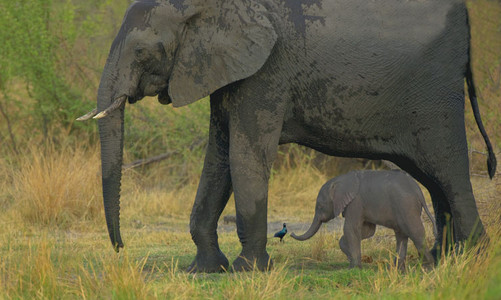
Baby Elephant + Glossy Starling
Elephant-Young baby (2-1/2 mos.) bneath mother and a Glossy starling in the background watching for insects stirred up by the elephants. [Khwai, Moremi NP, Botswana].
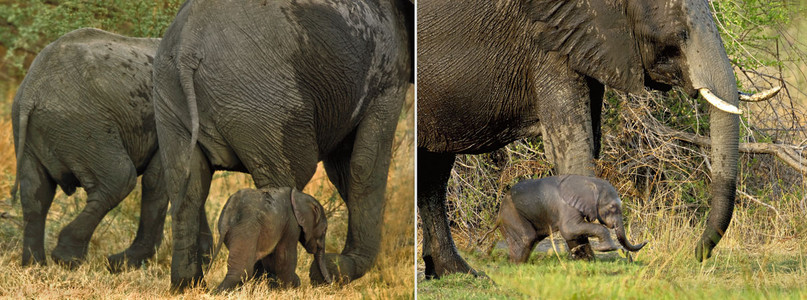
Baby Elephant
Elephant and her 4-week toto at its mother's feet in the woodlands. An 'aunt' is with the mother (dbl im). [Kuando, Botswana].
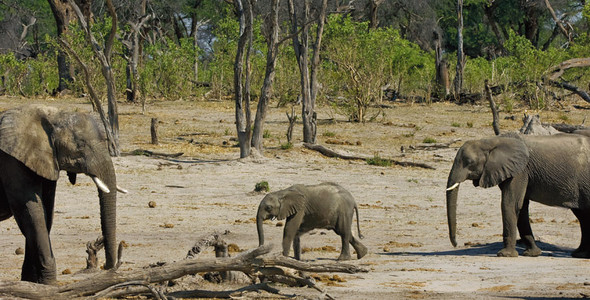
Elephant-Juvenile between 2 older Fem
Elephant-Juvenile between 2 older Females: The 8 month old is walking to its mother (L), being escorted by Its aunt (R). [Moremi NP, Botswana].
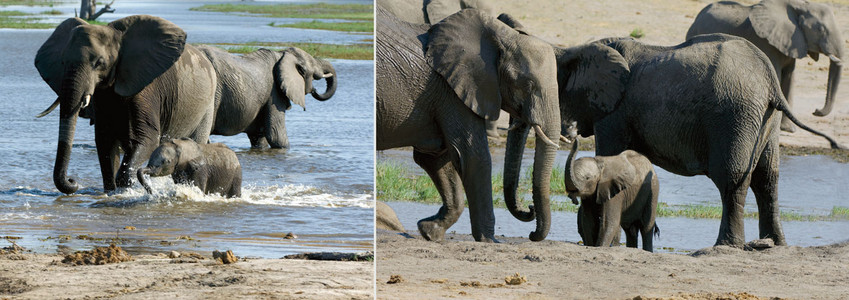
Elephants+Toto Bathing-dbl
Elephants mothers seem anxious to have their totos (5-6 mos.)(dbl. image) be very comfortable in the water.They take them to water at a very young age--much younger than shown here. {Moremi NP, Botswana].

Elephant Family - Evening
Several matriarchal groups of Elephants have gathered, with their juveniles, in the early evening. The youngsters played with each other and rolled in the soft mud. A little later they all went into the water for a bath. [Chobe River (nr Savuti), Botswana].
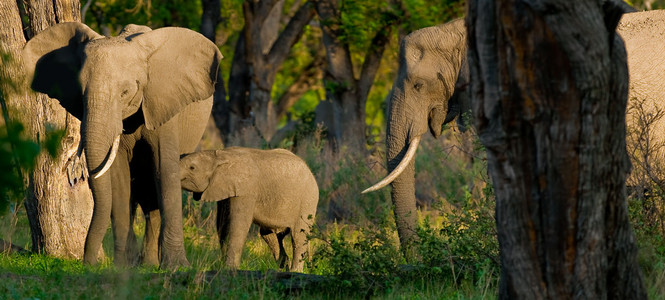
Baby Elephant Feeding
five-month baby Elephant suckles mother in woodlands, while grandma looks on contentedly. [Botswana].
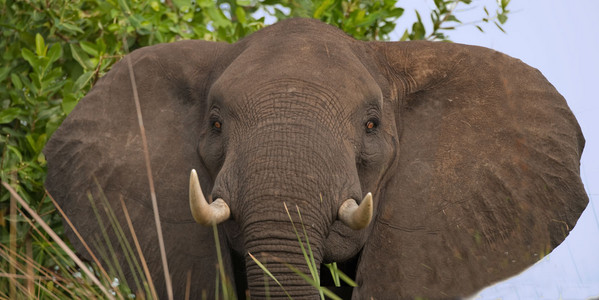
Large Bull Elephant
Large bull young adult Elephant extends its ears as it scrutinizes us in boat. [Botswana].
